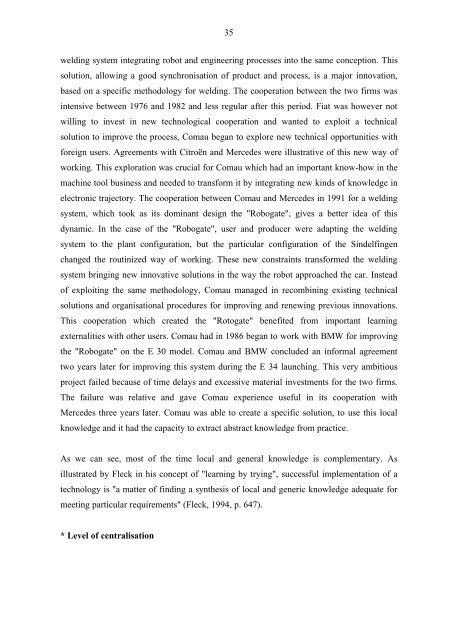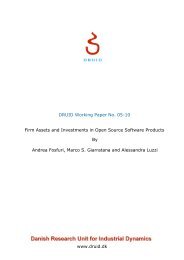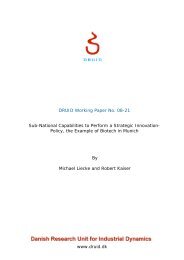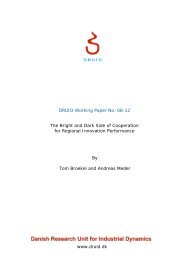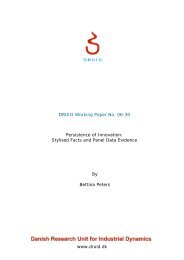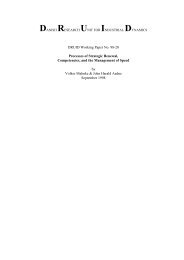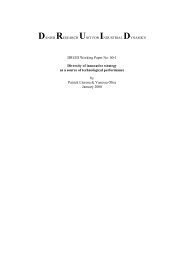danish research unit for industrial dynamics druid working paper no ...
danish research unit for industrial dynamics druid working paper no ...
danish research unit for industrial dynamics druid working paper no ...
You also want an ePaper? Increase the reach of your titles
YUMPU automatically turns print PDFs into web optimized ePapers that Google loves.
35welding system integrating robot and engineering processes into the same conception. Thissolution, allowing a good synchronisation of product and process, is a major in<strong>no</strong>vation,based on a specific methodology <strong>for</strong> welding. The cooperation between the two firms wasintensive between 1976 and 1982 and less regular after this period. Fiat was however <strong>no</strong>twilling to invest in new tech<strong>no</strong>logical cooperation and wanted to exploit a technicalsolution to improve the process, Comau began to explore new technical opport<strong>unit</strong>ies with<strong>for</strong>eign users. Agreements with Citroën and Mercedes were illustrative of this new way of<strong>working</strong>. This exploration was crucial <strong>for</strong> Comau which had an important k<strong>no</strong>w-how in themachine tool business and needed to trans<strong>for</strong>m it by integrating new kinds of k<strong>no</strong>wledge inelectronic trajectory. The cooperation between Comau and Mercedes in 1991 <strong>for</strong> a weldingsystem, which took as its dominant design the "Robogate", gives a better idea of thisdynamic. In the case of the "Robogate", user and producer were adapting the weldingsystem to the plant configuration, but the particular configuration of the Sindelfingenchanged the routinized way of <strong>working</strong>. These new constraints trans<strong>for</strong>med the weldingsystem bringing new in<strong>no</strong>vative solutions in the way the robot approached the car. Insteadof exploiting the same methodology, Comau managed in recombining existing technicalsolutions and organisational procedures <strong>for</strong> improving and renewing previous in<strong>no</strong>vations.This cooperation which created the "Rotogate" benefited from important learningexternalities with other users. Comau had in 1986 began to work with BMW <strong>for</strong> improvingthe "Robogate" on the E 30 model. Comau and BMW concluded an in<strong>for</strong>mal agreementtwo years later <strong>for</strong> improving this system during the E 34 launching. This very ambitiousproject failed because of time delays and excessive material investments <strong>for</strong> the two firms.The failure was relative and gave Comau experience useful in its cooperation withMercedes three years later. Comau was able to create a specific solution, to use this localk<strong>no</strong>wledge and it had the capacity to extract abstract k<strong>no</strong>wledge from practice.As we can see, most of the time local and general k<strong>no</strong>wledge is complementary. Asillustrated by Fleck in his concept of "learning by trying", successful implementation of atech<strong>no</strong>logy is "a matter of finding a synthesis of local and generic k<strong>no</strong>wledge adequate <strong>for</strong>meeting particular requirements" (Fleck, 1994, p. 647).* Level of centralisation


